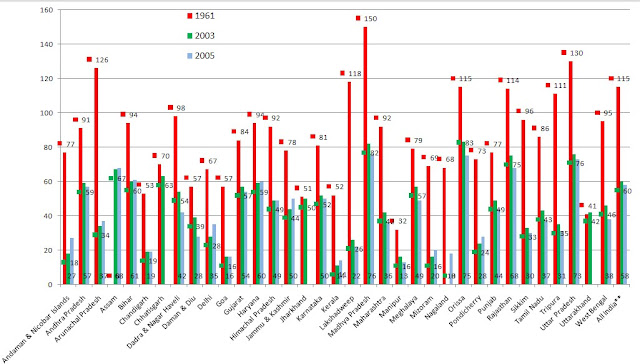STATE-WISE INFANT MORTALITY RATE (per1000) -
Year 1961, 2003 & 2005
As you can see, some states in India have come a long way but as a whole India is yet to tackle hunger and poverty.
The following are the states which are showing an upward trend and it seems to continue in year 2008 too.
The following are the 2008 figures for India:
The performance is not good while compared to other countries and China seems to be doing better even here.
The infant deaths can be due to hunger as well as the poor health of the mother. The healthier the mother, the more chance there would be for an infant to survive.
Four diseases-pneumonia, diarrhoea, malaria and AIDS-accounted for 43 per cent of all deaths in children under five worldwide in 2008. Pneumonia and diarrhoea together account for a third of all under-five deaths. Most of these lives could have been saved through low-cost prevention and treatment measures, including antibiotics for acute respiratory infections, oral rehydration for diarrhoea, immunization, and the use of insecticide-treated mosquito nets and appropriate drugs for malaria. The need to refocus attention on pneumonia and diarrhoea—two of the three leading killers of children—is urgent.
Worldwide mortality in children younger than 5 years has dropped from 11•9 million deaths in 1990 to
7•7 million deaths in 2010, consisting of 3•1 million neonatal deaths, 2•3 million postneonatal deaths, and 2•3 million childhood deaths (deaths in children aged 1–4 years). 33•0% of deaths in children younger than 5 years occur in south Asia and 49•6% occur in sub-Saharan Africa, with less than 1% of deaths occurring in high-income countries. Across 21 regions of the world, rates of neonatal, postneonatal, and childhood mortality are declining. The global decline from 1990 to 2010 is 2•1% per year for neonatal mortality, 2•3% for postneonatal mortality, and 2•2% for childhood mortality. In 13 regions of the world, including all regions in sub-Saharan Africa, there is evidence of accelerating declines from 2000 to 2010 compared with 1990 to 2000. Within sub-Saharan Africa, rates of decline have increased by more than 1% in Angola, Botswana, Cameroon, Congo, Democratic Republic of the Congo, Kenya, Lesotho, Liberia, Rwanda, Senegal, Sierra Leone, Swaziland, and The Gambia.
Source:
Neonatal, postneonatal, childhood, and under-5 mortality for 187 countries, 1970–2010: a systematic analysis of progress towards Millennium Development Goal 4 www. thelancet.com
http://indiabudget.nic.in/es2006-07/chapt2007/tab95.pdf
http://www.foodjustice.net/report/ngo-reports/india/India_Hunger_Index_2008.pdf/view
http://www.childinfo.org/mortality.html






You know, what I fail to understand is the upward swing! Especially in comparatively better off states like Kerala. I wonder what that upward swing indicates. Is there some specific reason why the trend is in the reverse..
ReplyDeleteAnyway, the overall statistics just goes to show how much we need to catch up with the rest of the world..
this is fantastic! It shows where we stand with the rest of the world. We spend very little money on improving the lot of just born, still less money on mother of just born and incase they survive all this and decide to live, absolutely zilch on educating the children. Unless we reverse the trend on the 8% or 9% growth rate and throwing rest of things to dustbin these statistics will get worse and worse.
ReplyDeleteUnlike other states, Kerala's food production has remained stagnant or eroded. That state's contribution to hunger alleviation is a sad story.
ReplyDeletehttp://www.tehelka.com/story_main45.asp?filename=Ws050610keralafood.asp
I think more than hunger, it is almost total absence of heath care that is responsible for this appalling picture. In 63 years, neither education nor quality health care has reached the masses out there. In states which are comparatively better developed, things are better. But a lot needs to be done. On a war footing.
ReplyDeleteSmitha: Yes.. it is alarming to note that these states have an upward swing.. The report on Kerala which uptake has shared does throw some light.. Kerala has been resting on it's laurels and soon may face food shortage. Every item in a meal would need to come from elsewhere! nd yes.. there is a long journey ahead..
ReplyDeleteERR: Yes.. the focus seems to be only on a few sectors which has a direct link with the stock market... if one cannot provide the basics for many then what is this % of growth rate that one is talking about.
uptake: thank you for the report.. it is sad to note about Kerala and I hope the improvement in rice production during the last few years is at least maintained.. I do not think Kerala can ever be self sufficient in food since land is being converted for other purposes too quickly.. this trend may not be reversible..
Vinod:Yes.. it is not just hunger but other basics like sanitation, pure drinking water and also education that needs to be provided. Unfortunately a section of the society surges ahead while even the basics are being denied for others.